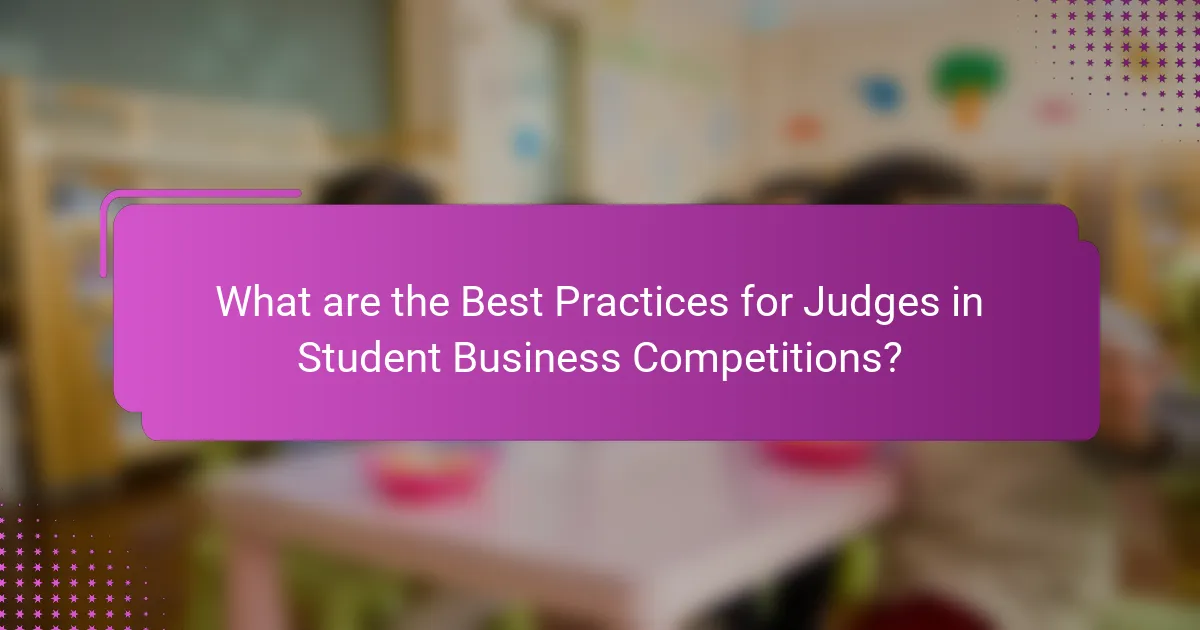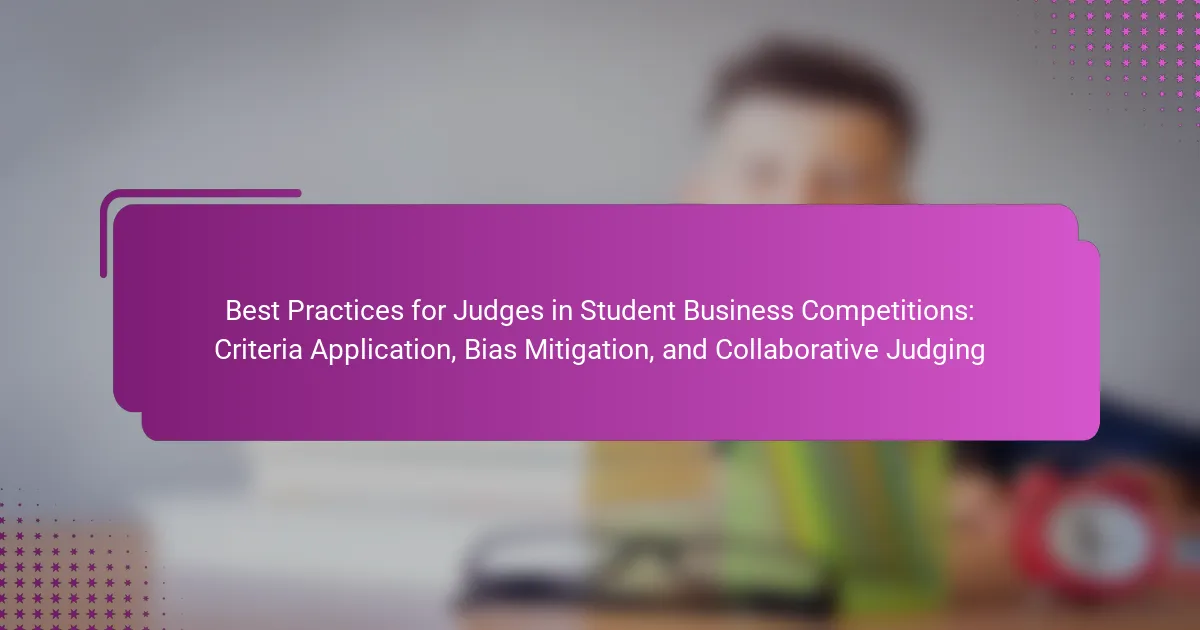Judges in student business competitions play a critical role in ensuring fairness and effectiveness in the evaluation process. Key best practices include establishing clear evaluation criteria to standardize assessments, providing constructive feedback to foster student development, and mitigating personal biases through the use of scoring rubrics. Collaboration among judges is encouraged to reach consensus on scores and perspectives, while maintaining professionalism and respect throughout the competition is essential for creating a positive environment for participants. Implementing these practices enhances the integrity and educational value of student business competitions.

What are the Best Practices for Judges in Student Business Competitions?
Judges in student business competitions should adhere to several best practices to ensure fairness and effectiveness. First, they must establish clear evaluation criteria before the competition begins. This ensures that all participants are assessed based on the same standards. Second, judges should provide constructive feedback to participants. This helps students learn and improve their business acumen. Third, judges should avoid personal biases during the evaluation process. They can achieve this by using a scoring rubric that focuses on specific performance metrics. Fourth, it is beneficial for judges to collaborate with each other. This can involve discussing scores and perspectives to reach a consensus. Finally, judges should remain professional and respectful throughout the competition. This creates a positive environment for participants. These practices enhance the integrity and educational value of student business competitions.
How should judges apply criteria in student business competitions?
Judges should apply criteria in student business competitions by using a standardized rubric. This rubric should clearly outline the evaluation metrics for each aspect of the competition. Each criterion must be weighted according to its importance to the overall business concept. Judges should score each submission independently to minimize bias. After individual scoring, judges can discuss their evaluations collaboratively. This discussion helps ensure consistency and fairness in the final scores. Research indicates that structured evaluation methods reduce subjective bias and improve decision-making accuracy. A study by McKinsey & Company found that standardized assessments lead to better outcomes in competitive environments.
What are the key criteria judges should consider during evaluations?
Judges should consider several key criteria during evaluations. These include clarity of presentation, which assesses how well participants communicate their ideas. Judges should evaluate the originality of the business concept, determining its uniqueness and innovation. Financial viability is another critical criterion, focusing on the feasibility of the business model and revenue potential. Judges must also consider the market analysis provided, which reflects the understanding of target customers and competition. Team dynamics and collaboration should be evaluated to assess how well team members work together. Lastly, judges should review the overall impact of the business idea, including its potential social or environmental benefits. These criteria ensure a comprehensive and fair evaluation process in student business competitions.
How can judges ensure consistency in criteria application?
Judges can ensure consistency in criteria application by developing clear and standardized rubrics. These rubrics should outline specific criteria and performance levels for evaluation. Training sessions can help judges understand and apply these criteria uniformly. Regular calibration meetings among judges can align their interpretations of the criteria. Documenting decisions with justifications can provide transparency and accountability. Research indicates that structured evaluation methods improve scoring reliability. For example, a study by the American Psychological Association found that clear rubrics enhance inter-rater reliability among judges.
Why is bias mitigation important for judges?
Bias mitigation is important for judges to ensure fairness and impartiality in decision-making. Judges’ biases can affect their evaluations and lead to unequal treatment of participants. In student business competitions, this could result in unfair advantages or disadvantages based on irrelevant factors. Research indicates that unconscious biases can influence judgments even when judges strive to be objective. For example, a study by Greenwald and Banaji (1995) demonstrated that implicit biases can affect evaluations across various domains. Therefore, implementing bias mitigation strategies helps uphold the integrity of the competition and fosters a level playing field for all participants.
What types of biases can affect judging in student competitions?
Judging in student competitions can be affected by several types of biases. Common biases include confirmation bias, where judges favor information that confirms their pre-existing beliefs. There is also halo effect bias, where a judge’s overall impression of a participant influences their evaluation of specific criteria. Another type is affinity bias, where judges favor participants with whom they share common backgrounds or experiences. Additionally, gender bias can occur, leading to unequal evaluation based on a participant’s gender. Research indicates that these biases can significantly impact the fairness of judging outcomes in competitions. For instance, a study published in the Journal of Business Ethics highlights how biases can skew decision-making processes in competitive environments.
How can judges identify and address their own biases?
Judges can identify and address their own biases through self-reflection and training. Self-reflection involves judges regularly examining their decision-making processes. This practice can help them recognize patterns of bias in their judgments. Training programs focused on implicit bias can enhance judges’ awareness of their biases. These programs often include workshops and discussions on bias recognition and management. Engaging in peer reviews allows judges to receive feedback on their decisions. This feedback can highlight potential biases in their evaluations. Additionally, utilizing structured evaluation criteria can minimize subjective judgments. By adhering to clear guidelines, judges can reduce the influence of personal biases. Research shows that structured decision-making leads to fairer outcomes in competitive settings.
What role does collaborative judging play in competitions?
Collaborative judging enhances fairness and accuracy in competitions. It involves multiple judges working together to evaluate participants. This approach mitigates individual biases that may affect scoring. Research shows that collaborative judging leads to more balanced assessments. For instance, a study by the American Psychological Association indicates that group decisions are often more reliable than individual ones. Collaborative judging also fosters diverse perspectives, enriching the evaluation process. It encourages dialogue among judges, which can clarify criteria and improve consistency. Overall, collaborative judging plays a critical role in ensuring equitable outcomes in competitive settings.
How can collaboration among judges enhance the evaluation process?
Collaboration among judges enhances the evaluation process by promoting diverse perspectives and reducing bias. When judges work together, they share insights and experiences that lead to more balanced assessments. This teamwork helps in identifying potential biases that individual judges may overlook. Studies show that collaborative judging can improve the overall quality of evaluations. For example, a research study indicated that teams of judges achieved higher reliability in scoring compared to individual assessments. Additionally, collaboration fosters open discussions that clarify criteria and expectations. This transparency helps ensure that all judges are aligned in their evaluations. Ultimately, collaboration among judges leads to fairer and more accurate outcomes in competitions.
What are effective strategies for collaborative judging?
Effective strategies for collaborative judging include establishing clear guidelines and criteria. Judges should engage in preliminary discussions to align their expectations. Regular communication throughout the judging process ensures consistency in evaluations. Utilizing a shared scoring system can reduce discrepancies among judges. Feedback sessions after initial evaluations help refine assessments. Documenting discussions fosters transparency and accountability. Training sessions on bias mitigation can enhance fairness in judging. Continuous reflection on the judging process improves future collaborations.
How do judges transition from criteria application to bias mitigation?
Judges transition from criteria application to bias mitigation by employing structured decision-making frameworks. These frameworks guide judges in evaluating submissions based on objective criteria. Judges must remain aware of personal biases that could influence their assessments. They can utilize training programs focused on recognizing and addressing bias. Engaging in discussions with fellow judges promotes diverse perspectives, which aids in reducing bias. Research indicates that collaborative judging can enhance fairness and objectivity in evaluations. By actively reflecting on their decision-making processes, judges can identify potential biases. This systematic approach ensures a more equitable judging process in student business competitions.
What are the connections between collaborative judging and bias mitigation?
Collaborative judging can significantly reduce bias in evaluation processes. This approach involves multiple judges assessing submissions together. It encourages diverse perspectives, which can counter individual biases. Research shows that group decision-making tends to balance out personal biases. A study by Surowiecki (2004) emphasizes that collective intelligence often leads to better outcomes. Collaborative judges can challenge each other’s assumptions and judgments. This dialogue fosters a more equitable assessment environment. Overall, collaborative judging enhances fairness and objectivity in evaluations.
What specific techniques can judges use to improve their evaluation process?
Judges can improve their evaluation process by implementing structured rubrics. Structured rubrics provide clear criteria for assessment. They help judges maintain consistency and objectivity in scoring. Judges can also engage in calibration sessions. Calibration sessions allow judges to align their evaluation standards. This practice reduces discrepancies in scoring among judges. Another technique is to utilize blind judging. Blind judging minimizes bias by concealing participants’ identities. Additionally, judges can incorporate feedback mechanisms. Feedback mechanisms enable judges to reflect on their evaluations and improve over time. Lastly, judges should encourage collaboration among peers. Collaborative judging fosters diverse perspectives and enhances decision-making accuracy.
How can judges provide constructive feedback to participants?
Judges can provide constructive feedback to participants by focusing on specific strengths and areas for improvement. Feedback should be clear, actionable, and based on observable behaviors. Judges should use examples from the presentation to illustrate their points. This approach helps participants understand what they did well and what needs enhancement. Constructive feedback fosters a positive learning environment. It encourages participants to develop their skills further. Research shows that specific, relevant feedback improves performance in educational settings. Providing balanced feedback, highlighting both strengths and weaknesses, is essential for effective communication.
What best practices should judges follow for effective communication with participants?
Judges should prioritize clarity and transparency in communication with participants. Clear instructions help participants understand expectations. Judges must provide constructive feedback to guide improvement. Active listening is crucial; judges should engage with participants’ questions and concerns. Maintaining a respectful tone fosters a positive environment. Judges should also ensure that communication is timely, especially regarding decisions. Using accessible language prevents misunderstandings. Lastly, judges should be consistent in their messaging to reinforce fairness and credibility. These practices enhance participant experience and uphold the integrity of the competition.
Best Practices for Judges in Student Business Competitions focus on ensuring fairness and effectiveness through clear evaluation criteria, constructive feedback, and bias mitigation. The article outlines key evaluation criteria, including presentation clarity, originality, financial viability, and team dynamics. It emphasizes the importance of collaborative judging to enhance consistency and reduce biases, while also providing strategies for judges to improve their evaluation processes. Additionally, it discusses techniques for delivering constructive feedback and maintaining effective communication with participants.
